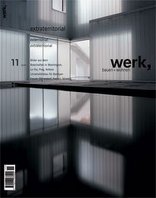Zeitschrift
werk, bauen + wohnen 11-06
Extraterritorial
The pictures circulating around the world in autumn of 1989 were highly dramatic: hundreds of citizens of East Germany shown clambering over the railings of the West German embassies in Prague, Warsaw and Budapest, where thanks to the extraterritorial status of the embassy grounds they could be given protection as refugees. Embassies are sensitive areas in several ways. The host country guarantees their external protection, whereas the embassies themselves handle security within the embassy grounds. The era of threats and attacks has led to many embassies being converted into fortresses. Anyone seen behaving strangely in the surroundings of an embassy runs the risk of immediate arrest. In Berne, where most countries have their embassies, in addition to a number of aloof, fortified complexes there are also some that signalise an open hospitality. However embassies are not merely administrative and political agencies but also places that represent and portray their respective countries. Nations that can afford it tend to prefer a dignified presentation and like to employ a kind of sovereign grandezza, whereby hierarchical distinctions are drawn between the ambassador's residence and the chancellery buildings. Other countries are more modest and rent accommodation in urban residential and commercial buildings. For werk, bauen + wohnen Christian Schwager has photographed ten foreign embassies, whose buildings range from a „Swiss“ châlet to a neo-Baroque mansion and an urban high-rise building, and thus illustrate a broad spectrum of types. Where the embassies of the individual states are located in a host country may, to some extent, be a matter of chance. It is a very different matter indeed when a nation decides to build itself a new embassy in a foreign country. What role does architecture play here? Should it be Swiss architects who design Swiss embassies? Should the architecture bear an immediately identifiable Swiss stamp or is an approach to local usage more appropriate? These are the questions that always arise when architects leave their native country to build abroad. They are questions that deeply affect the problem of cultural transfer with all its connotations, both positive and negative. In the age of globalisation in which the import and export of architecture is celebrating a revival and the construction industry often fails to recognise foreign sensibilities and sensitivities this seems to us to be a particularly topical theme and one that is worthwhile reflecting on. We present new Swiss embassy buildings in Washington, La Paz and Prague, report on a courageous building project in Bamiyan, Afghanistan and take a retrospective glance at the early years of Swiss architect Emil Egli, who in 1927 was called to Ankara as head architect of the Turkish Ministry of Education and with his modern buildings helped to realise Atatürk's vision of a new Turkey. The Editors
Thema
Einladung nach Bern
Fotografien von Christian Schwager
Botschaften bauen
Ein Gespräch mit Doris Wälchli und Ueli Brauen
Kontraste und Schattierungen Residenz der Schweizer Botschaft in Washington von Steven Holl Architects und Rüssli Architekten | Sabine von Fischer
Komplexe Botschaften Ernst Eglis Gesandtschaftsgebäude der Schweiz in Ankara | Oya Atalay Franck
Ein Luftschloss aus Lehm ETH House of Science in Bamiyan, Afghanistan, von Ivica Brnic, Florian Graf und Wolfgang Rossbauer | Axel Simon
Forum
Kolumne: Igor Bauersima
EFH: Strohhaus in Eschenz TG von Felix Jerusalem
Wettbewerb: Architekturwettbewerb «Triangel» in Parpan
Bauten: Forum Chriesbach EAWAG/EMPA von Bob Gysin + Partner BGP Architekten und Implenia Generalunternehmung
Bauten: Bâtiment des Communications BC des EPFL-Campus von Luscher Architectes, Lausanne
Projekt: Anmerkungen zum Erweiterungsprojekt für die Messe in Basel von Herzog & de Meuron
Auszeichnung: Heinrich-Tessenow-Medaille an Sergison Bates
Innenarchitektur: Design und Innenarchitektur mit Bambus
Ausstellung: Die 10. internationale Architekturausstellung in Venedig
bauen + rechten: St. Galler Baurechtstagung 2006
Ausstellungen | Veranstaltungen | Wettbewerbe
Produkte | Neuerscheinungen
werk-Material
Bob Gysin + Partner BGP Architekten Zürich, Implenia Generalunternehmung Dietlikon ZH:
Forum Chriesbach EAWAG/EMPA in Dübendorf ZH
Luscher Architectes, Lausanne: Bâtiment des Communications BC des EPFL-Campus in Lausanne
Thema
Einladung nach Bern
Fotografien von Christian Schwager
Botschaften bauen
Ein Gespräch mit Doris Wälchli und Ueli Brauen
Kontraste und Schattierungen Residenz der Schweizer Botschaft in Washington von Steven Holl Architects und Rüssli Architekten | Sabine von Fischer
Komplexe Botschaften Ernst Eglis Gesandtschaftsgebäude der Schweiz in Ankara | Oya Atalay Franck
Ein Luftschloss aus Lehm ETH House of Science in Bamiyan, Afghanistan, von Ivica Brnic, Florian Graf und Wolfgang Rossbauer | Axel Simon
Forum
Kolumne: Igor Bauersima
EFH: Strohhaus in Eschenz TG von Felix Jerusalem
Wettbewerb: Architekturwettbewerb «Triangel» in Parpan
Bauten: Forum Chriesbach EAWAG/EMPA von Bob Gysin + Partner BGP Architekten und Implenia Generalunternehmung
Bauten: Bâtiment des Communications BC des EPFL-Campus von Luscher Architectes, Lausanne
Projekt: Anmerkungen zum Erweiterungsprojekt für die Messe in Basel von Herzog & de Meuron
Auszeichnung: Heinrich-Tessenow-Medaille an Sergison Bates
Innenarchitektur: Design und Innenarchitektur mit Bambus
Ausstellung: Die 10. internationale Architekturausstellung in Venedig
bauen + rechten: St. Galler Baurechtstagung 2006
Ausstellungen | Veranstaltungen | Wettbewerbe
Produkte | Neuerscheinungen
werk-Material
Bob Gysin + Partner BGP Architekten Zürich, Implenia Generalunternehmung Dietlikon ZH:
Forum Chriesbach EAWAG/EMPA in Dübendorf ZH
Luscher Architectes, Lausanne: Bâtiment des Communications BC des EPFL-Campus in Lausanne
Weiterführende Links:
Verlag Werk AG







